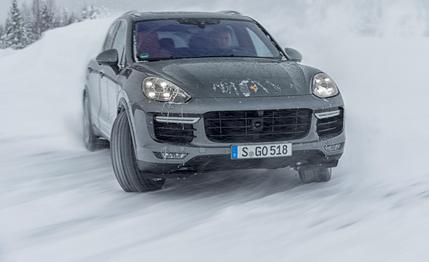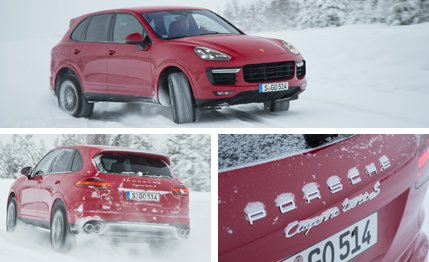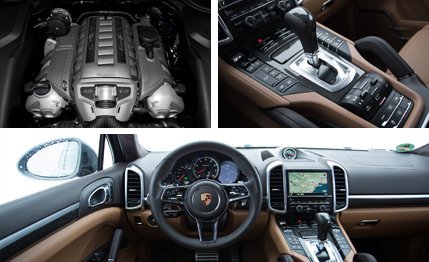
 First Drive Review
First Drive Review
Two model years in, Porsche has determined that its Cayenne Turbo S just wasn’t sufficiently excessive, so here’s the 2016 edition, going even further over the top in pursuit of, well, more. So much more that the company claims the big beast can lap the Nürburgring in 7 minutes, 59 seconds, making it the first SUV to break the eight-minute barrier and eclipsing the 8:14 lap Range Rover was touting last summer for its Range Rover Sport SVR. Pretty impressive, even if Porsche’s frequent references to the Cayenne as a “four-door sports car” kept reminding us of the 4DSC stickers on 1990s Nissan Maximas.
In our test of the 2014 Cayenne Turbo S, we marveled at an SUV boasting “550 freakin’ horsepower”—a figure the Range Rover has since matched and BMW has exceeded (with its 567-hp X5 M). Clearly, Stuttgart would have to do something. So now, thanks to having its dual turbochargers integrated into the exhaust manifold where they can deliver boost more quickly and efficiently, the Porsche’s number is 570 freakin’ horsepower. Torque also increases by 37 lb-ft to a mind-boggling 590 lb-ft; Porsche Traction Management, all-wheel drive, and a torque-vectoring rear axle help deliver it to the road.
Porsche claims fuel efficiency is “improved,” as well, but then acknowledges that the 2016 Turbo S gets the same Euro-cycle combined mileage ratings as before. Because if you make more power with the same amount of fuel, yes, technically your efficiency has improved. The earlier model delivered 15 mpg in our test.


Not that buyers who opt for the maximum dose of Cayenne pepper are likely to get squeamish over the cost of the premium-grade unleaded the 4.8-liter V-8 ingests. The base MSRP has ballooned to $158,295, but the Turbo S now comes standard with carbon-ceramic mega-brakes (with 10-pot calipers up front, four-piston units in back), whereas the older model charged $8840 for that option (with mere six-piston front grabbers). Never fear, though: Porsche’s remaining array of expensive customizations ($1640 carbon-fiber grab handles, anyone?) make it easy to push the bottom line up into the $200,000 zone.
All this arrives in U.S. dealerships by April, alongside the 2016 Cayenne GTS. As with that model, our first turn behind the wheel of a Turbo S came in northern Sweden in and around Skellefteå, a hockey-crazed town that has produced many star players. It’s also the birthplace of Stieg Larsson, the late author of the Millennium Trilogy (The Girl with the Dragon Tattoo). Porsche didn’t mention this factoid, perhaps because Larsson’s villains were the very wealthy industrialists and bankers likely to figure among Cayenne Turbo S buyers.
Skellefteå was founded as a mining town—suitably enough, there’s gold (and silver, and copper) in those snow-covered hills. When our drive route pointed up one grade that looked relatively free of icy perils, we slammed the gas pedal to the floor and were rewarded with a near-instant surge of power and a lightning-quick downshift from the eight-speed automatic gearbox—we couldn’t have paddled down from eighth gear to third as swiftly as the electronics did it in Sport mode. The V-8’s growl and the quick surge forward lasted only a moment before the electronics intervened. There’s only so much that technology can do, and creating traction where there isn’t much is not within its purview, despite the driving habits often exhibited by four-by-four owners in winter.


When we got off the open road and onto the Skellefteå Drive Center, we could turn off all the electronic assists, dial up Sport Plus and tromp aggressively on the go pedal. On an iced skidpad, this made for lovely four-wheel-drifting action but not a lot of forward momentum. There’s enough grunt here that we can imagine doing the same on pavement, at greater expense for tires. The former airbase also had a cavern we could drive through to enjoy the echo of the exhaust note resonating off rock without wondering if our ears had been deceived by some engineered cabin-ambience tuning.
Otherwise, we spent a lot of time fiddling with an array of buttons and knobs reminiscent of the space shuttle’s dashboard and admiring the craftsmanship that goes into covering every square inch of this big box’s interior with leather, suede, wood, carbon fiber, or unobtainium (buyer’s choice, at a price).
We wish we could tell you more about the driving, beyond our general preference for the more driver-oriented GTS’s steering and handling responses. Whatever advantage 570 horsepower confers simply wasn’t on offer because conditions were so far removed from those Walter Röhrl had seen at the Nürburgring. The driving legend himself was present to give thrill rides, and very impressive ones they were, belying his 67 years. But his mount for these rides was a 911 Turbo S. Röhrl may have the chops to make a two-and-a-half ton SUV set the fast time of the day on any road or rally course you name, but given his druthers, it appears he’d prefer a proper two-door sports car if it’s all the same to you.